Public Procurement Survey of Suppliers: analysis 2020
An analysis of findings from the Public Procurement Survey of Suppliers 2020.
3. Main findings
In this section, we provide an in-depth analysis of the responses to the main sections of the survey. In doing so, we explore a range of topics, such as:
- the nature of contracts suppliers have bid for and delivered;
- training, support and advice on the tendering process;
- the tendering process itself;
- feedback on tenders;
- support for suppliers concerned with a procurement exercise;
- suppliers' experiences of sub-contracting;
- the impact of recent work to improve Scottish public sector procurement;
- the COVID-19 pandemic.
Nature of contracts bid for and/or delivered
Despite our respondents largely being from businesses of a relatively small size, respondents reported bidding for contracts of a wide variety of sizes in terms of contract value. As shown in Figure 3.1, 47% of respondents indicated that they typically tender for contracts valued at between £10,000 and £49,999, while 45% reported that they usually tender for contracts with a value of over £190,000.
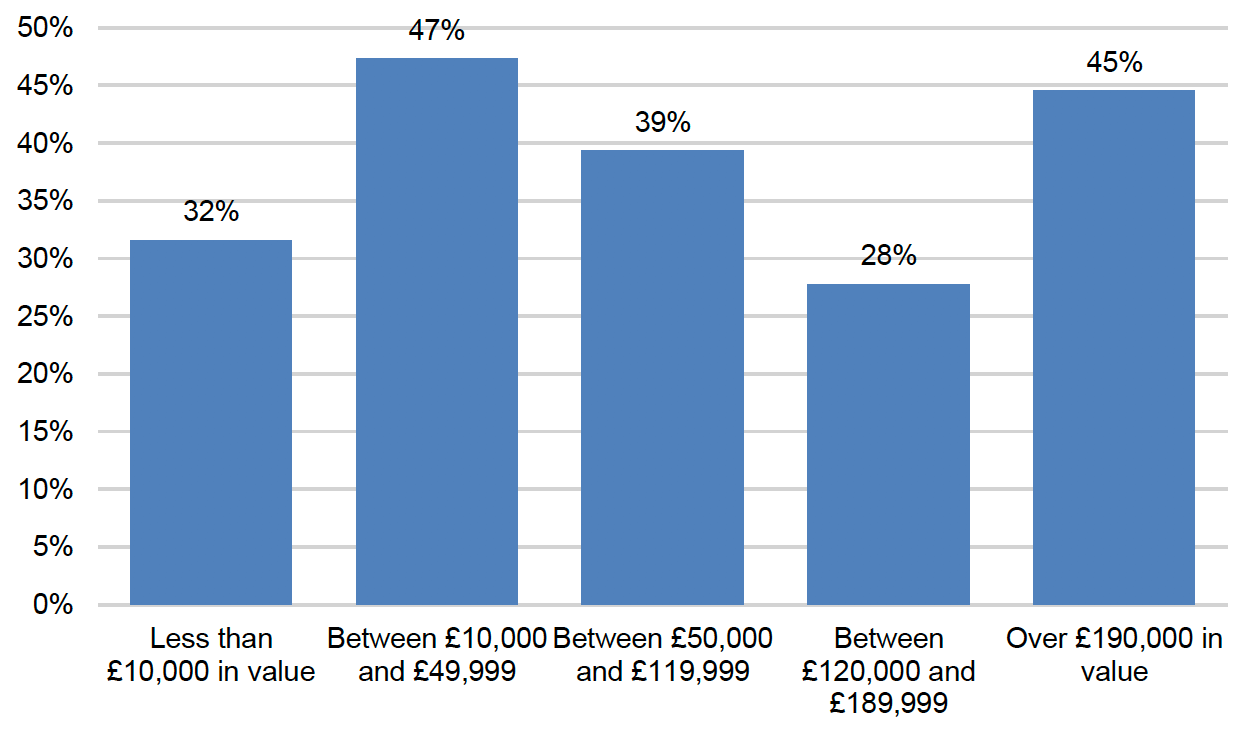
Typically, suppliers bid for a relatively small number of contracts. We asked respondents about the number of contracts they had tendered for in the last two years and, separately, the number of contracts they had won during the same period (Figure 3.2).
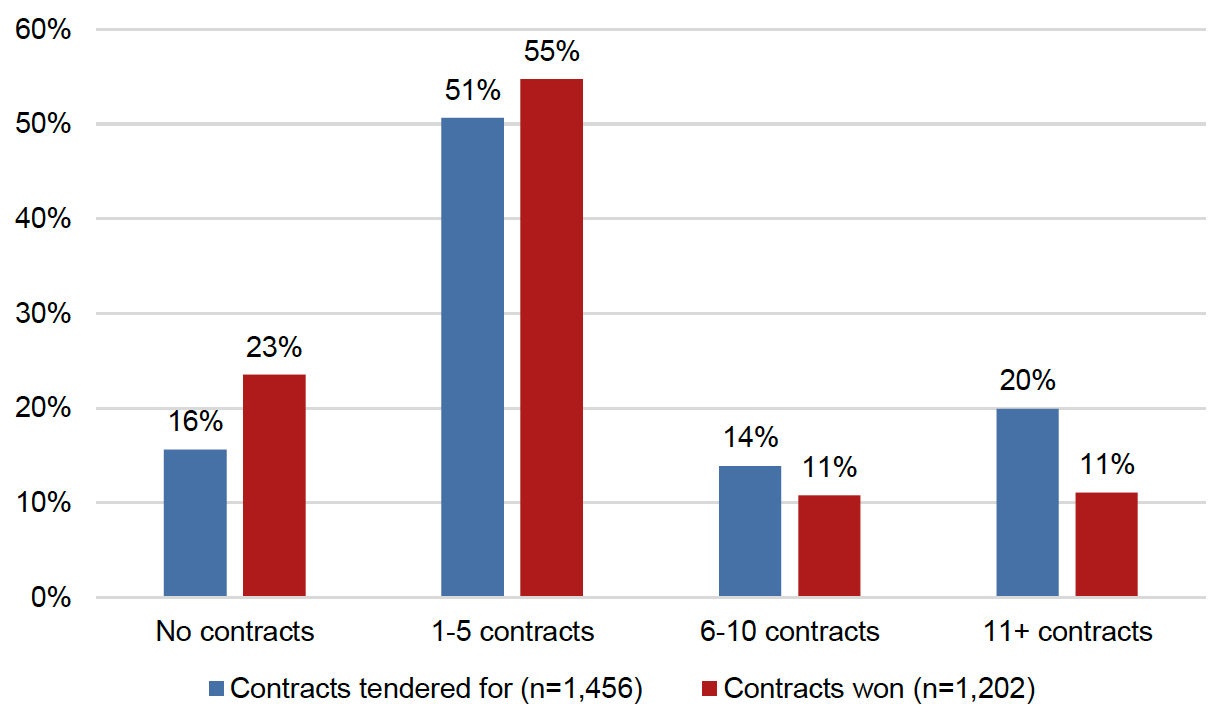
As Figure 3.2 shows, the majority of respondents indicated that they had tendered for and won between one and five contracts in the last two years (51% and 55% respectively).
Evidently, however, some suppliers are notworking with the Scottish public sector. A significant proportion of respondents (16%) reported that they had not tendered for any contracts in the last two years. Some sectors were especially likely to report not tendering. For example:
- of 328 respondents who classified their business as belonging to the 'other service activities' sector, 20% reported having not tendered for any contracts in the last two years;
- 20% of firms in the manufacturing industry reported not having tendered for any contracts in the last two years. 33% of firms in the electricity, gas, steam and air conditioning supply sector had not tendered in the last two years.
Respondents from organisations that had not recently tendered for a Scottish public sector contract expressed some challenges with regard to access to contracts. When asked why they had not tendered, most often, respondents said there was a lack of suitable opportunities to tender for. As one supplier noted, their lack of awareness of any opportunities did not necessarily mean that these opportunities did not exist – rather, that it was simply a case of finding the opportunities.
"No suitable tender opportunities were brought to my notice. This may in part be due to the way opportunities are classified. The system seems to find it difficult to classify tenders in my area of work [which is] natural and cultural heritage [and] museums."
Other less common reasons given for organisations not tendering included organisations being new to the tendering process, or difficulties navigating a seemingly complex system. For example, as one respondent said:
"We did not tender because we think it is way too complex to do it and certain things … are confusing [even though] we possess over 20 years of experience in IT. There is a lot room for improvement in your tendering system."
On the other hand, a few respondents reported that they did not tender because they already had sufficient amounts of work.
Contracts with local government have been particularly attractive to suppliers. We asked respondents to identify which parts of the Scottish public sector were covered by the contracts they had tendered for in the last two years and, separately, by the contracts they won over the same period (Figure 3.3).
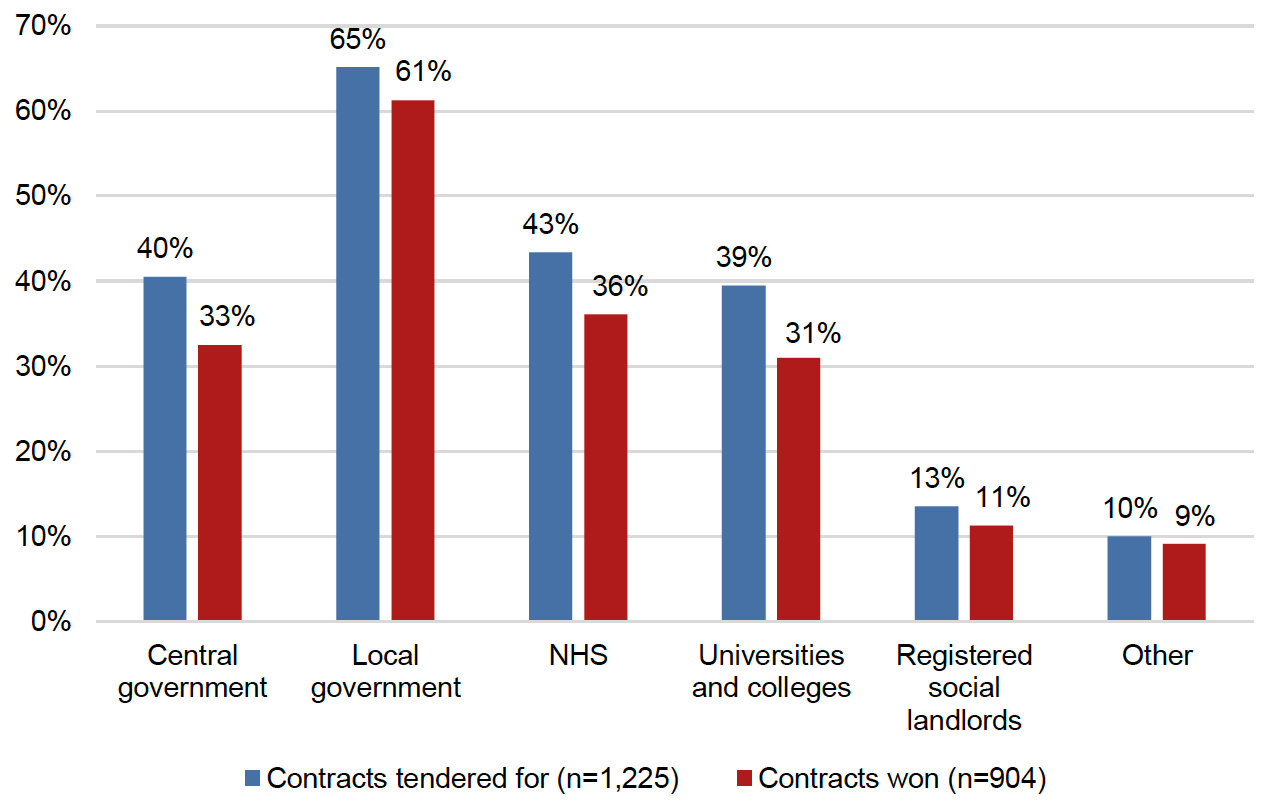
The local government sector accounted for around two thirds of all contracting activity with survey respondents in the last two years, with 65% of respondents indicating that they had tendered for a contract with the local government sector during this period and 61% reporting having won a contract with the sector (Figure 3.3). The predominance of the local government sector in the tendering process is also reflected in the findings from the analysis of the 2018 to 2019 cycle of annual procurement reports, which found that the local government sector accounted for the highest number of regulated contracts awarded in that year.
Public sector contracts are a notable source of income for the suppliers who completed our survey, although suppliers are by no means reliant on such income. Figure 3.4 below provides information about the proportion of organisations' annual turnover in the last two years that can be accounted for by winning Scottish public sector contracts and, separately, by working on public contracts as a sub-contractor.
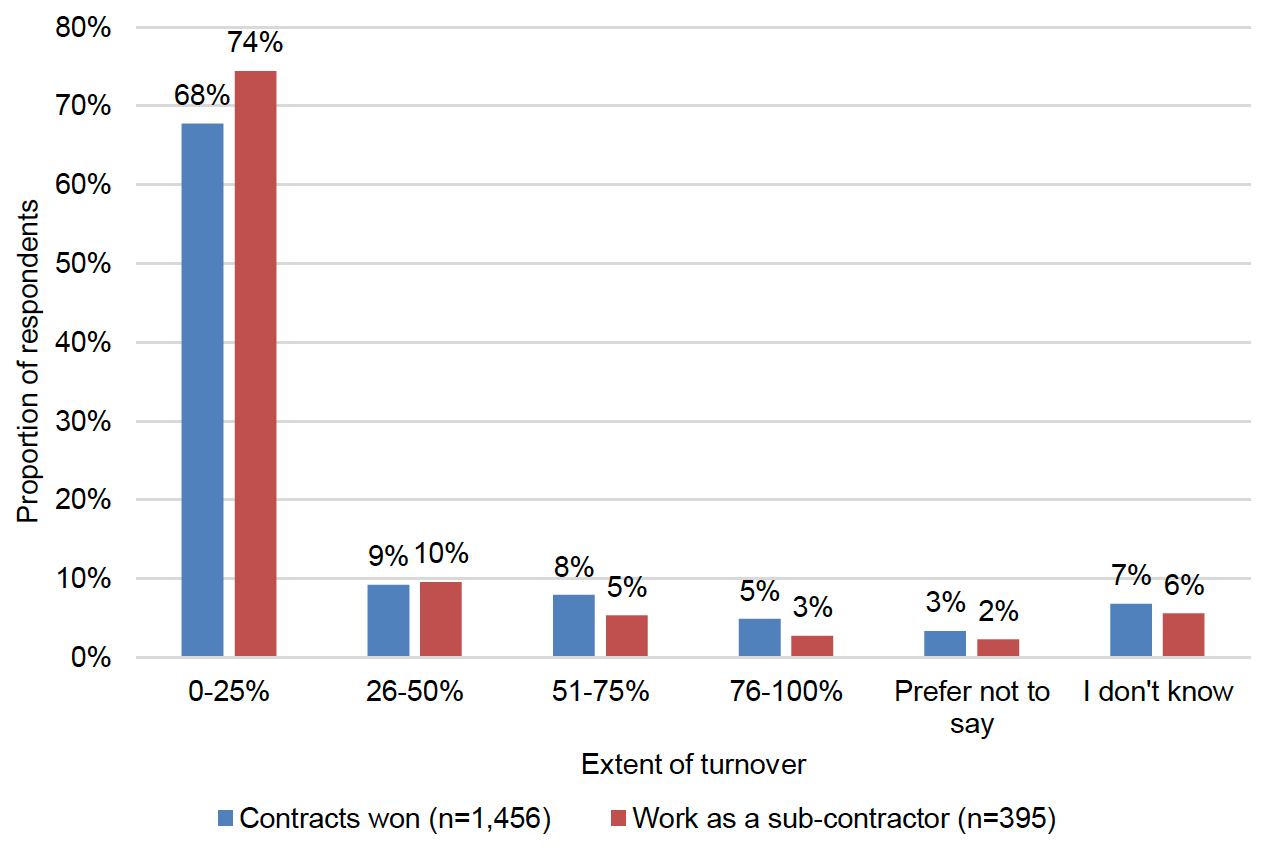
For most respondents, Scottish public sector contracts accounted for up to 25% of their organisation's annual turnover in the last two years, with 68% indicating this for contracts won and 74% specifically for their sub-contracting work. More will be said about respondents' experience of sub-contracting later in this section.
While consortium bidding is important in enabling relatively small organisations to gain experience of delivering relatively large contracts, this practice remains uncommon. Of 1,549 respondents, 13% indicated that their organisation had experience of delivering a Scottish public sector contract as part of a consortium bid.
Training, support and advice on tendering
The provision of training, support and advice on the tendering process is of vital importance to the public procurement landscape. For example, the Supplier Development Programme provides training and support to SMEs, supported businesses and local businesses in relation to all aspects of the tendering process, with the aim of helping them to become "tender ready". In doing so, the programme improves the efficiency, sustainability and market potential of these organisations while bringing greater competition to the overall procurement process.[16]
The survey shows that a range of sources of training, support and advice on tendering for Scottish public sector contracts exists, however take-up is limited. Of 1,552 respondents, less than a third (28%) indicated that they – or someone else in their organisation – had received training, support or advice on tendering at some stage, while 62% had not and 10% did not know.
Generally, those suppliers who are more experienced in tendering for Scottish public sector contracts were more likely to report receiving training, support or advice on the tendering process. Among the 353 respondents who indicated having over 20 years of experience in tendering for Scottish public sector contracts, 32% said that they – or someone in their organisation – had received training, support or advice on tendering at any stage. Among the 309 respondents whose organisation had 11-20 years of experience in tendering, the corresponding figure was 34%.
On the other hand, across 261 organisations with less than two years of tendering experience, 21% reported receiving training, support or advice on tendering. Among the 97 suppliers who had never tendered for a contract, the corresponding figure was 9%. These findings suggest that there is a need for those responsible for delivering training, support or advice on tendering to consider how to more effectively target suppliers with relatively less established histories of tendering for Scottish public sector contracts. Ultimately, this will improve the overall competitiveness of the procurement process.
Figure 3.5 below shows the source of the training, support or advice received across all respondents.
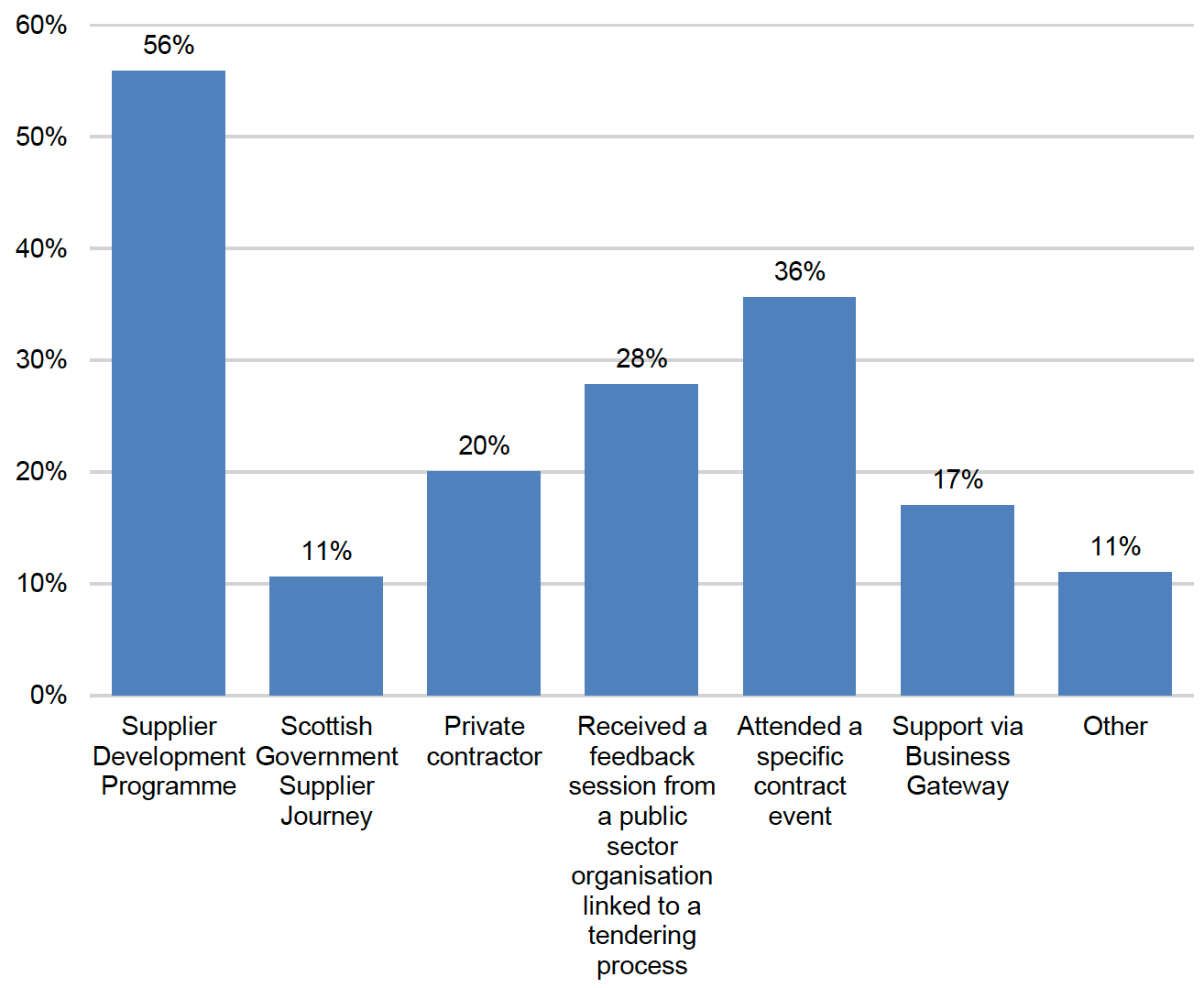
As shown above, the Supplier Development Programme was the most common source of the training, support or advice that respondents received, with 56% indicating as such. This was followed by training, support or advice from attending contract events (36%) and receiving feedback sessions from a public body in connection with a tendering process (28%).
Eleven per cent of respondents indicated that they had received training, support or advice from other sources. Of these respondents, when asked to specify the source of this training, support or advice, around half highlighted external sources of support, for example from universities or independent consultants. Around a quarter had received support from internal sources, for example from other members of their team or from internal training events.[17]
More could be done to improve the visibility of the training, support and advice available to suppliers. When the 62% of respondents who said that neither they nor anyone else in their organisation had received any training, support or advice on tendering were asked why not,[18] of 965 respondents, almost three quarters (71%) said that they did not know free tender training was available. Additionally:
- 27% said they did not have enough time to seek support;
- 4% felt the training was too expensive;
- 13% cited other reasons – among these respondents, many felt they simply did not require any support with tenders, while some did not think that training would help them.
While many suppliers are taking up the opportunities for training, support or advice that are available through the Supplier Development Programme, more could be done to promote the programme to ensure that it reaches as many suppliers as possible:
- 43% of respondents reported that they were aware – or their organisation was aware – of the Supplier Development Programme (n=1,552).
- One quarter (25%) said that they – or someone in their organisation – had previously attended a Supplier Development Programme training event or webinar (n=1,545).
- Around a third (32%) reported that they – or someone in their organisation – had attended a Supplier Development Programme 'Meet the Buyer' event (n=1,551).
The tendering process
Generally, the organisations which responded to the survey felt relatively well-equipped to tackle the process of tendering for a Scottish public sector contract. We asked them to rate their organisations' ability on a variety of aspects of the tendering process (Figure 3.6).
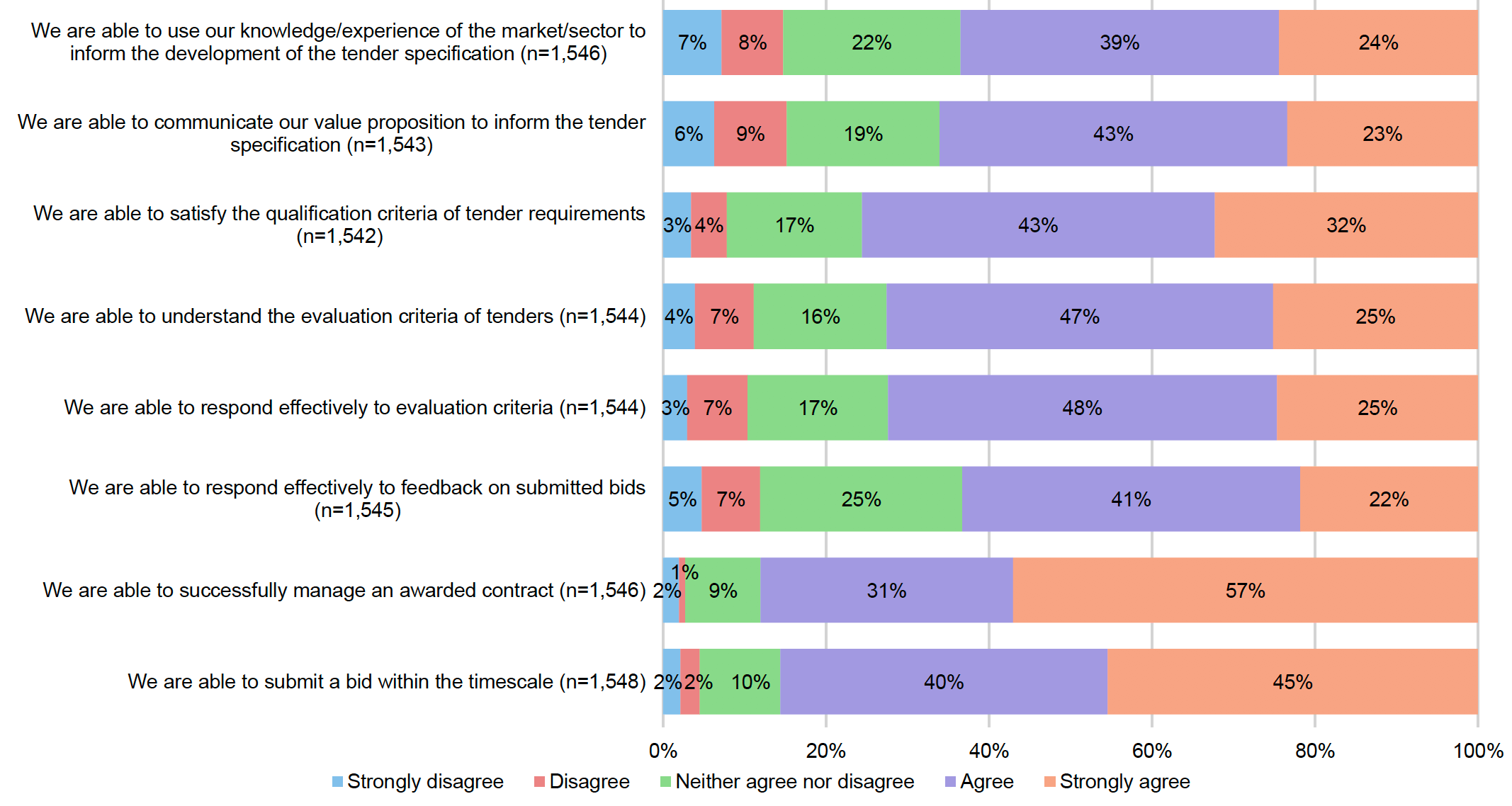
As shown above, respondents were particularly confident in their ability to manage an awarded contract successfully, with 88% reporting that they either 'agreed' or 'strongly agreed' they were able to do so. Eighty-six per cent 'agreed' or 'strongly agreed' that they were able to submit a bid within the timescale, while 76% 'agreed' or 'strongly agreed' that they were able to satisfy the qualification criteria of tender requirements.
Respondents were less confident in other areas. In particular, 15% either 'disagreed' or 'strongly disagreed' that they were able to use their knowledge and experience of the market or sector to inform the development of the tender specification, while the same proportion also 'disagreed' or 'strongly disagreed' that they were able to communicate their value proposition to inform the tender specification.
When asked to comment further on their tendering abilities, there was a strong sense from many that the tendering process is viewed as being complex and burdensome, with many respondents highlighting that they often encounter stringent, and/or unclear tender requirements, coupled with quick turnarounds. For example, as one respondent said:
"[The] timescale from ITT to submission is crucial so that resources can be assigned to create a good response. Some tenders have a two week turnaround, which is much too short. Responding to a tender takes significant time from the supplier. This is increased if there is duplication, confliction, or vagueness in the request document. Some tenders are [over] 175 pages, some are [around] 25 pages…. If tenders get to the submission stage and the project is then stopped, submitting suppliers should be compensated for time spent."
Some felt that SMEs and local firms faced additional barriers due to the complexities of the system, largely because of their lack of experience of the bidding process or lack of resources to submit a bid. For example, another supplier said:
"Tender specifications tend to be generic and 'tick boxy' or too broad or diverse, such that it excludes smaller organisations with specialist or limited capacity or [they are] too specific such that you feel they have been developed with a particular supplier in mind…. The requirements, even with PCS tender where you have often filled much of the stuff in before, tend to be ridiculously onerous for small organisations."
Others highlighted their own lack of experience of tendering and their need for more support with the tendering process, or public bodies' lack of knowledge about the supplier base and the goods, works or services being tendered for.
To further elucidate some of the challenges faced in bidding for and delivering contracts, we asked respondents to indicate which of a series of difficulties they had faced (Figure 3.7).
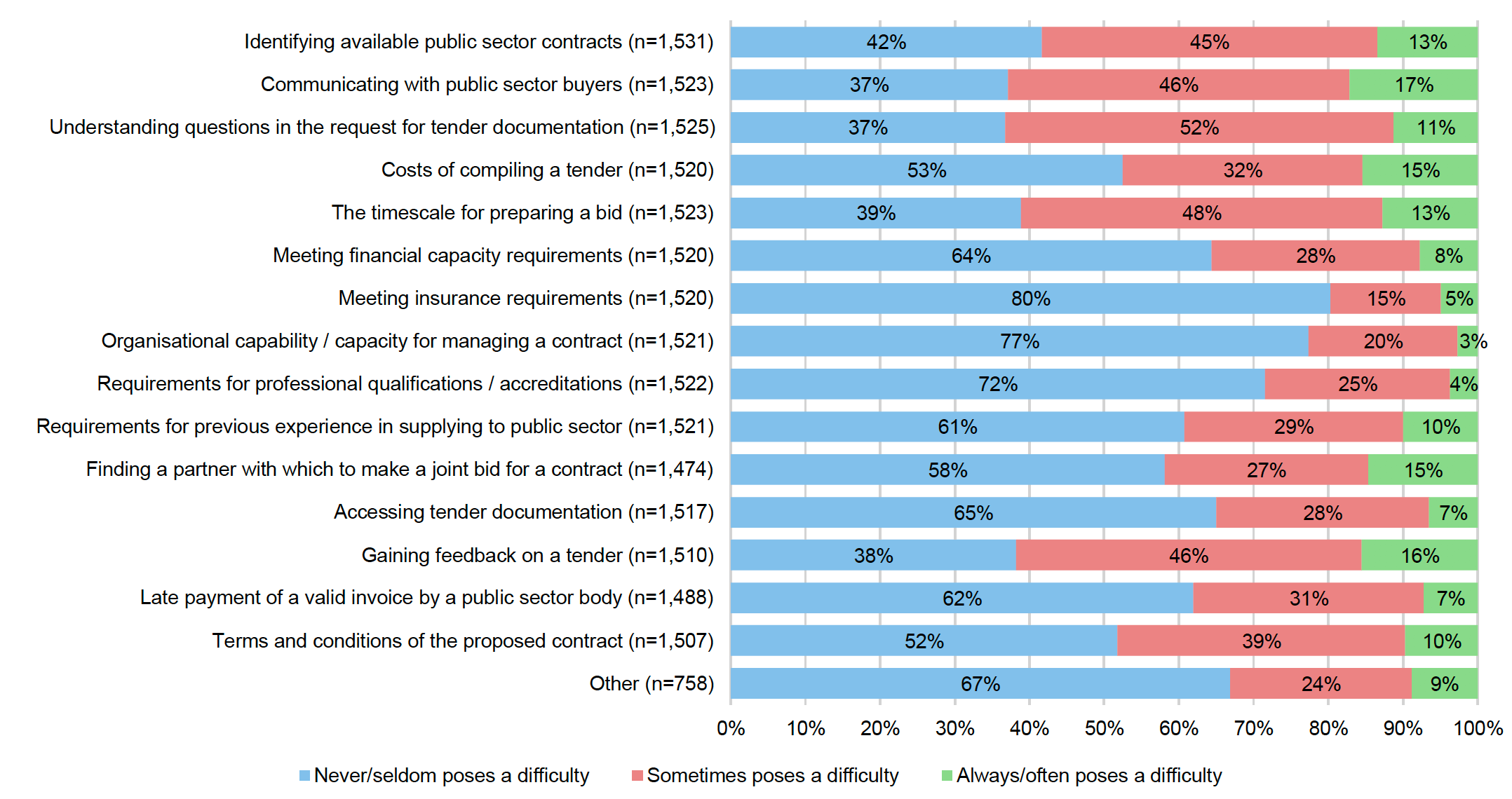
As shown above, suppliers experience a wide range of difficulties 'sometimes' or 'always/often', and the presence of some of these difficulties again suggests that suppliers view the tendering process as overly-complicated and onerous. In particular, 63% of respondents said that they experience difficulties communicating with public sector buyers 'sometimes' or 'always/often', with the same proportion also 'sometimes' or 'always/often' finding it difficult to understand the questions asked in the request for tender documentation. Furthermore:
- 62% of respondents stated that they 'sometimes' or 'always/often' experience difficulties gaining feedback on a tender;
- 61% said they experience difficulties with the timescales for preparing a bid 'sometimes' or 'always/often';
- 58% reported experiencing difficulties identifying available public sector contracts 'sometimes' or 'always/often'.
The issue of access to public contracts is especially pertinent to SMEs. SMEs are more likely than large businesses to experience difficulties with identifying available contracts; 61% of SMEs reported experiencing difficulties identifying contracts 'sometimes' or 'always/often', compared to 42% of large businesses.
Respondents in the information and communication sector were especially likely to experience difficulties identifying contracts. Of the 129 respondents in this sector, 70% indicated that they experienced these difficulties 'sometimes' or 'always/often'. Of 198 respondents in the professional, scientific and technical activities sector, the corresponding figure was 61%
Clearly, other elements of the tendering process or of contract delivery are less challenging. Respondents were least likely to encounter difficulties with meeting insurance requirements, with 80% reporting that they 'never/seldom' had any difficulties with this. This is followed by organisational capability or capacity to manage a public sector contract (77% 'never/seldom' had difficulties with this) and meeting requirements for professional qualifications and accreditations (72%).
As Figure 3.7 shows, 31% of respondents indicated that they 'sometimes' or 'always/often' experienced other difficulties. When asked to explain what other difficulties they experienced, they often referred to poor formatting, a lack of clarity and/or the use of jargon in invitations to tender. Others again highlighted the stringent nature of the tendering process, the often vast amounts of information required and the short timescales for submission. For example, as one respondent said:
"We find that sometimes the Word documents that have been provided by buyers for suppliers to complete and submit as part of their bid are poorly formatted and, in some instances, unusable. In the past, I have found myself having to recreate an exact replica of the Word document that is useable so as to meet the formatting requirements of the buyer. This adds on time to an already lengthy process."
A few respondents also reflected on the lack of communication from public bodies – for example, in relation to the goods, works and services being tendered for, or in relation to the outcome of procurement decisions.
We also asked respondents how they felt about the ways in which public bodies conduct their procurement exercises – in particular, whether procurement exercises are carried out with regard to various key principles and policy objectives. The Scottish Government seeks to ensure that public procurement is conducted in line with the core principles of equal treatment, non-discrimination, transparency and proportionality, and also with a range of other policy objectives – for example, facilitating the involvement of SMEs and achieving value for money. Evidence from the survey suggests that these principles and policies are largely being reflected in procurement practice and contract delivery (Figure 3.8).
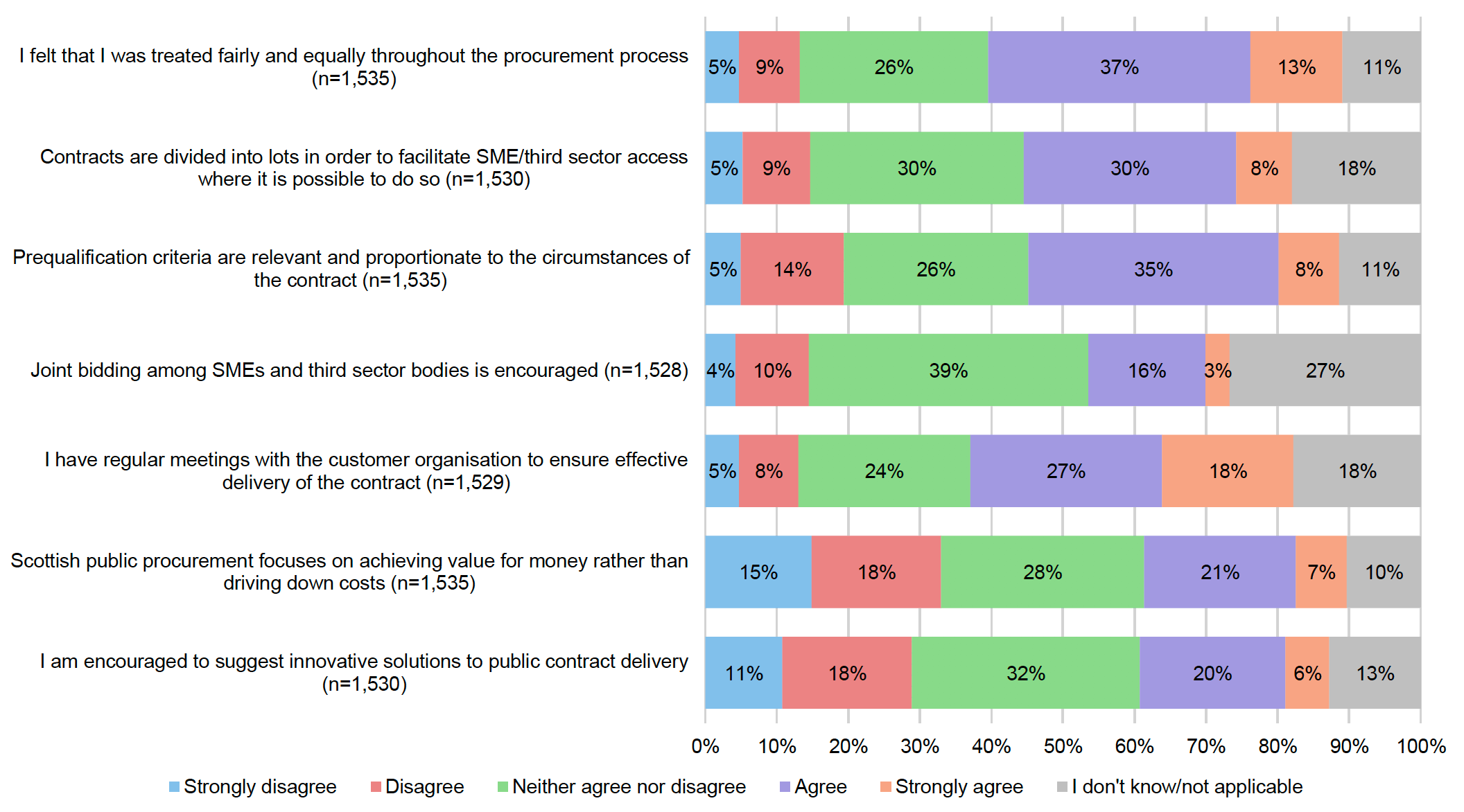
On the whole, the picture painted of Scottish public procurement – in respect of the above – is generally a positive one. For example, half (50%) of respondents 'agreed' or 'strongly agreed' that they were treated fairly and equally throughout the procurement process. Moreover:
- 45% of respondents 'agreed' or 'strongly agreed' that they have regular meetings with the customer organisation to ensure effective contract delivery;
- 43% 'agreed' or 'strongly agreed' that prequalification criteria are relevant and proportionate to the circumstances of the contract;
- 38% 'agreed' or 'strongly agreed' that contracts are divided into lots to encourage SME and third sector access, where possible.
SMEs are less confident than large businesses that contracts are being divided into lots to encourage SME and third sector access. Thirty-six per cent of SMEs 'agreed' or 'strongly agreed' with this statement, compared with 47% of large businesses.
Broken down by sector, respondents from the information and communication sector were more likely than average to hold less favourable views on the use of lotting to enable access to contracts. Twenty-one per cent of respondents in this sector 'disagreed' or 'strongly disagreed' that contracts are divided into lots to facilitate access among SMEs and third sector organisations (compared with 15% of all firms).
In other areas, respondents highlighted that there is some room for improvement – in particular, in relation to value for money and innovation, the latter of which is a key component of the Sustainable Procurement Duty. One third (33%) 'disagreed' or 'strongly disagreed' that Scottish public procurement focuses on achieving value for money rather than driving down costs (i.e. through achieving an appropriate balance of cost, quality and sustainability), while 29% 'disagreed' or 'strongly disagreed' that they are encouraged to suggest innovative solutions to contract delivery.
Suppliers are generally encouraged to consider a range of aspects of public procurement during the tendering process, particularly where they relate to the Sustainable Procurement Duty. Certain aspects of public procurement – and the Duty – are given more prominence than others. In our survey, we asked suppliers to indicate how often they are asked to consider a range of topics during the bidding stage, from community benefits to innovation (Figure 3.9).
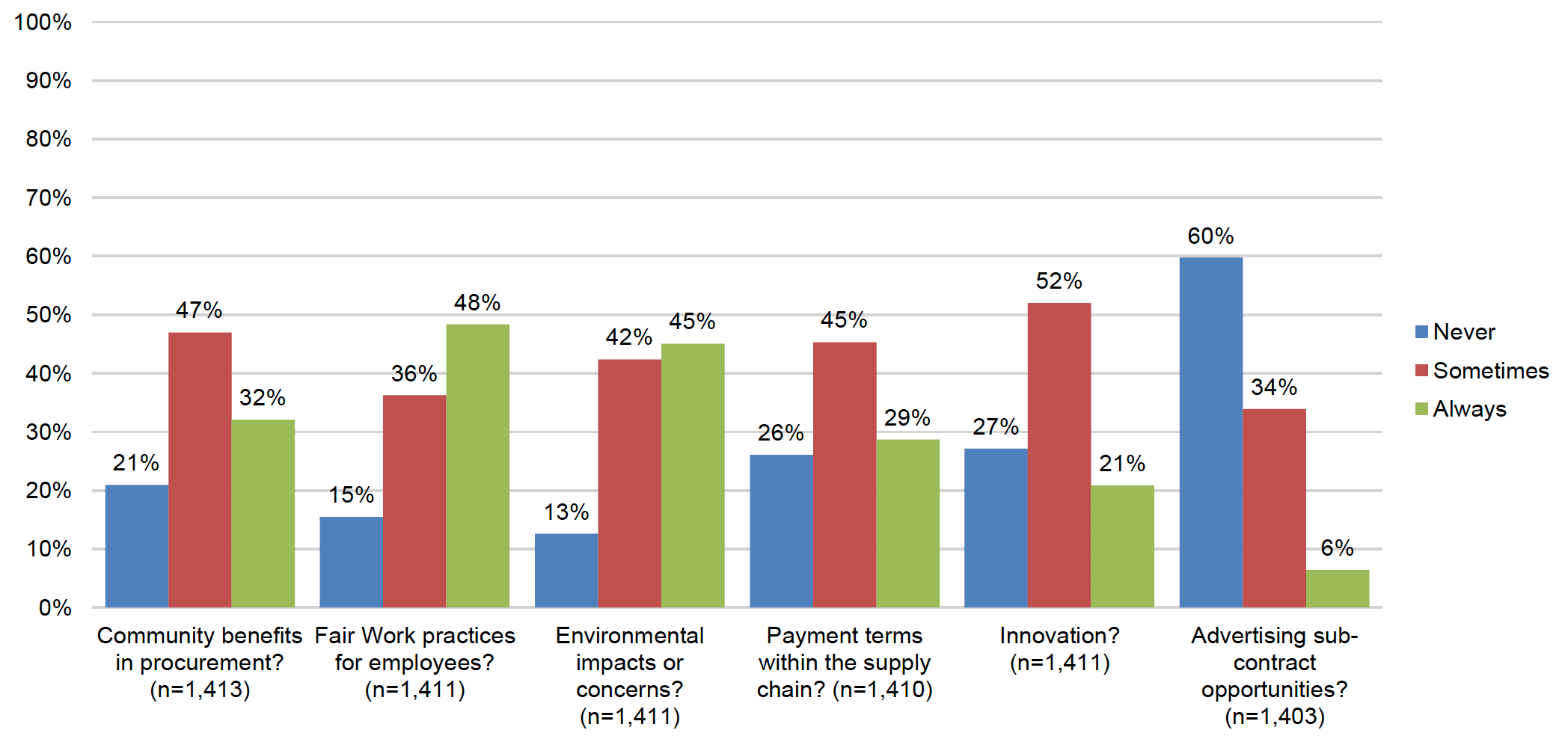
Generally, most respondents reported being asked to consider most of the above, 'sometimes' or 'always'. The only exception to this is advertising sub-contract opportunities, with 60% of respondents indicating that they were 'never' asked to consider this. In particular, respondents were most likely to be asked to consider environmental impacts or concerns (with 87% being asked to consider this 'sometimes' or 'always'), followed by Fair Work (85%) and community benefits in procurement (79%).
There is a clear opportunity for public bodies to encourage greater consideration of innovation during the procurement process. Twenty-seven per cent of respondents indicated that they have 'never' been asked to consider innovation in the bidding process. This is broadly in line with recent research on the impact and value of the Sustainable Procurement Duty which found that public bodies required most support with this particular strand of the Duty – namely, support to promote innovation, to be able to define it, and to report on it effectively.[19]
Feedback on tenders
Adequate provision of feedback on tender exercises is important in aiding suppliers to understand their strengths and weaknesses and to improve the quality of future bids. This, in turn, brings added competitiveness to the procurement process.
On the whole, while many suppliers are taking up opportunities to request feedback, some choose not to engage in this process. We asked respondents whether they requested feedback from public bodies on any tenders submitted in the last two years, regardless of whether they won the contract. Of 1,206 respondents, over a third (36%) requested feedback on all of their tenders, 34% requested feedback on some and 30% did not request feedback on any.
There are a range of reasons as to why suppliers may not always request feedback. Among our respondents, several felt that feedback was not necessary – for example, because they won the contract, because they already had some awareness of the weaknesses in their bid or because they did not think it would help. Some stressed that they did not have the time to request feedback, while others said that feedback was often readily provided without having to ask for it.
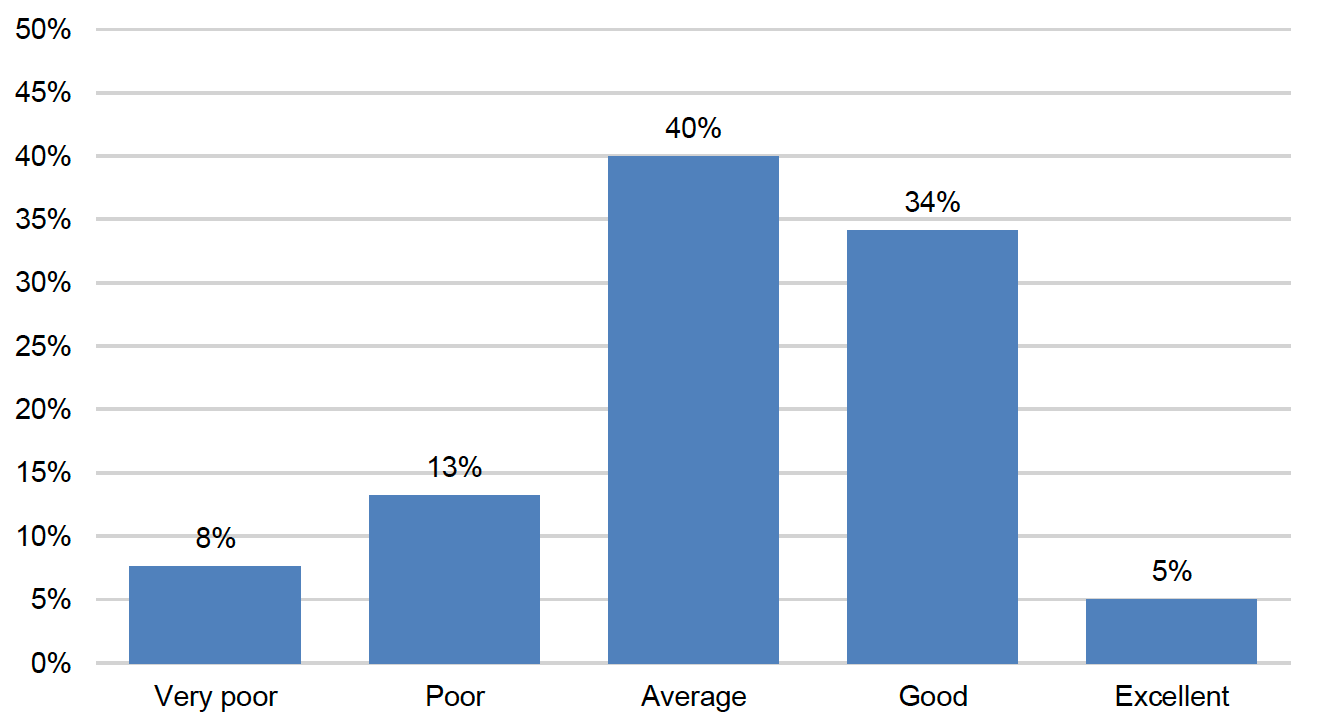
Where feedback has been requested, the overall quality of the feedback received is generally of a good – or at least acceptable – standard. Thirty-nine per cent of respondents rated the quality of feedback on their tenders as either 'good' or 'excellent', while 40% considered the quality of the feedback to be 'average'.
Among the respondents who rated the feedback they received as 'good' or 'excellent', when asked to explain their positive rating, they often stressed that the feedback was clear and concise, or that they were provided with full and detailed explanations behind awarding decisions. Others highlighted that feedback was usually provided on time and without them having to chase it up, and recognised the benefits of requesting feedback for the business and/or for future tenders. As one respondent said:
"Feedback is usually provided in a timely manner and is usually sufficiently detailed to be of use and interest."
However, around one fifth (21%) of respondents rated the feedback they had received as either 'poor' or 'very poor'. Some of these respondents mentioned that they did not always receive feedback, even when they had specifically requested it. Others felt that the feedback received often lacked detail, or that it was too generic or vague. A few disagreed with the feedback they had received.
Support for suppliers concerned with a procurement exercise
In recent years, suppliers have generally been happy with the procurement exercises they have been involved in. We asked respondents whether their organisation had been unhappy about a procurement exercise carried out by a Scottish public body, at any stage in the last two years – out of 1,474 respondents, over two thirds (67%) indicated 'no'.
A range of options are available to suppliers who have been unhappy about a recent procurement exercise, however these options are not always utilised or even known to suppliers. We asked suppliers who had been unhappy with a recent procurement exercise what action, if any, they took in response (Figure 3.11).
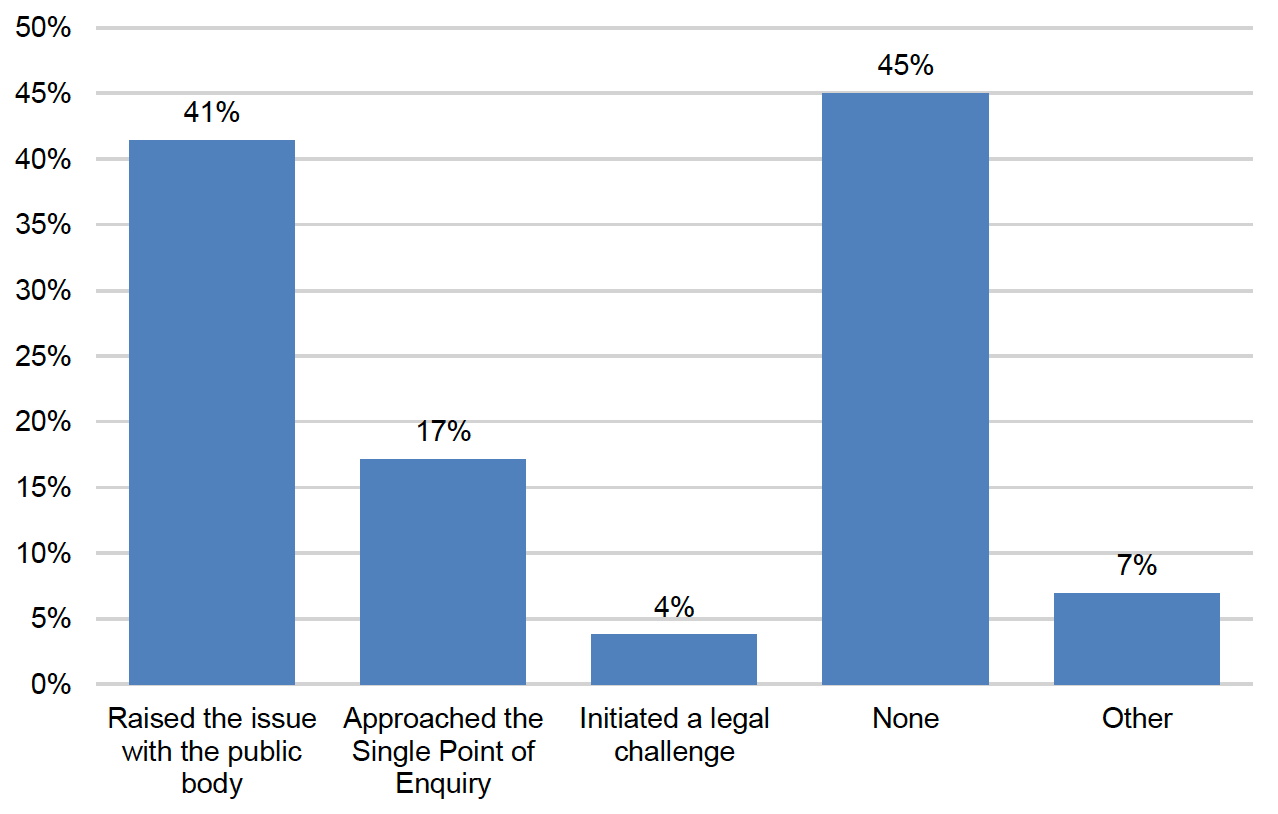
As shown above, 41% of respondents indicated that they raised the issue with the public body, while 17% approached the Single Point of Enquiry (SPoE) and 4% initiated a legal challenge. However, most commonly, respondents took no action at all, with almost half (45%) of respondents indicating as such.
Among those who took no action, most often, respondents stressed that they did not act because they felt that there was no point, or that it would be a waste of time. Several respondents also expressed concerns that taking any kind of action against a public body would lead to reputational damage or would harm their chances of working with that public body again in future. As one respondent said:
"[There is] no point in pursuing. [One time] I did challenge a grossly unfair practice (majorly late payments 60 days and against the law by a local authority) and our company were never asked to work again with that authority who previously had been a long standing and significant customer. That is the reality of things."
Single Point of Enquiry
The relatively low take-up of support from the SPoE likely reflects a wider lack of awareness of the service among suppliers. We asked respondents whether their organisation was aware of the SPoE. Out of 1,464 respondents:
- over three quarters (78%) of respondents were not aware of the service;
- 15% were aware of the service but had not made use of it – typically because they felt they had never needed to;
- 6% were aware of it and had made use of it.
Where suppliers do turn to the SPoE for support, the data presents a mixed picture in relation to the quality of the service. We asked respondents who had used the SPoE in the past how satisfied they were with the service they received. Around one third (34%) reported being satisfied or very satisfied with the service. These respondents praised the service for being useful, willing to help and quick to respond. As one supplier said, the SPoE is "always ready to listen and answer questions" and felt that it is "excellent that we have this aspect to public procurement and it provides reassurance".
Thirty-eight per cent of respondents were either unsatisfied or very unsatisfied with the service they received from the SPoE. Typically, they either stressed that the service had not helped them and/or highlighted the lack of, or delayed, response from the service. For example, we heard that in one case, "they only repeated what was in the wording of the tender and requested [that I] contact [the] procurement body". Some respondents also felt that the SPoE lacks the power to effectively challenge decisions about individual procurement exercises – as one respondent said, "the body lacks teeth and really does not interrogate the decision in any serious penetrating manner".
Legal challenges
As shown in Figure 3.11, most suppliers do not consider initiating a legal challenge following an unsuccessful tender. This is underlined by other evidence from elsewhere in the survey; we asked respondents whether they had considered initiating a legal challenge following an unsuccessful tender at any stage regardless of whether they pursued this – just 10% indicated 'yes'.
Where suppliers do consider initiating a legal challenge, the evidence suggests they are likely to experience a range of barriers in making their case. Out of a relatively small sample of 168 respondents, 41% reported experiencing barriers to initiating a legal challenge. Figure 3.12 below provides further information about the range of barriers encountered by respondents.
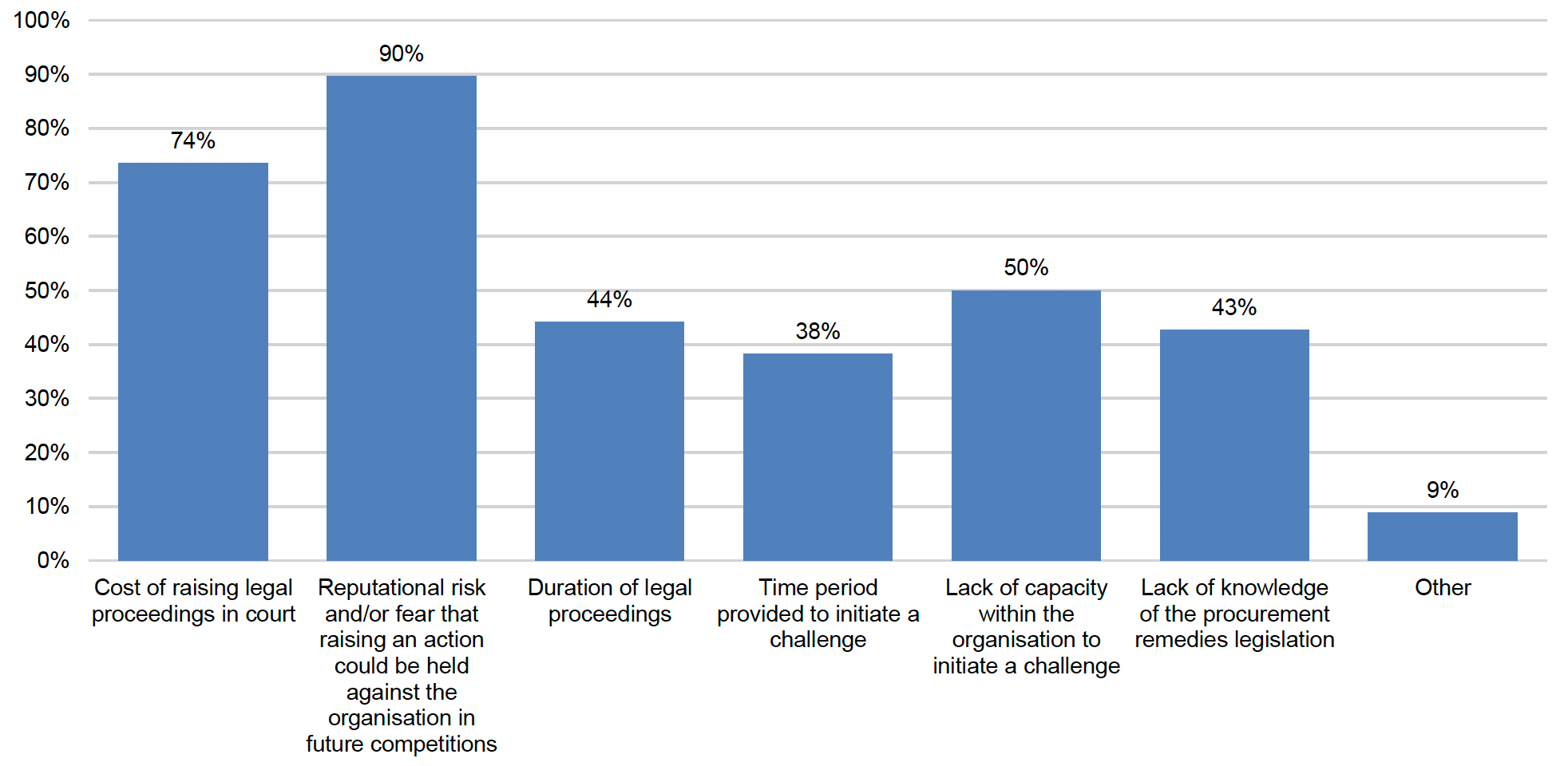
Owing to the small sample size of 68 respondents, care must be taken in drawing any definitive conclusions about the nature of any barriers to initiating legal challenges. Among this sample, clearly, the biggest barrier to mounting a legal challenge (as reported by 90% of respondents in the sample) is the fear of reputational risk, or that raising an action could be held against the supplier in future procurement exercises. Around three quarters (74%) of suppliers in the sample also highlighted the costs of raising legal proceedings as a significant barrier, while one half (50%) indicated that their organisation lacked capacity to initiate a legal challenge.
Experiences of sub-contracting
A significant proportion of those who have worked with the Scottish public sector have done so through sub-contracting arrangements. Of all 1,556 respondents, one quarter (25%, or 395) said that their organisation had previously been involved in delivering a contract as a sub-contractor.
Suppliers in some sectors were more likely to report being involved in sub-contracting work. When broken down by sector, out of 229 respondents from firms in the construction sector, 41% indicated that they had been involved in the delivery of a Scottish public sector contract as a sub-contractor. Out of 202 respondents from firms in the professional, scientific and technical activities sector, the corresponding figure was 39%.
Most respondents indicated that their sub-contracting experiences had been positive, with 59% (of 394 respondents) rating their organisations' experiences of delivering a contract as a sub-contractor as either 'good' or 'excellent'.[20] When asked to explain, respondents often highlighted that the contract was well-organised, efficient and straightforward, or stressed the importance of having a good relationship with others in the supply chain. As one respondent said:
"We are [a] sub-contractor to a college delivering a national service and the focus both parties put on developing and maintaining a trusted advisor relationship throughout the contract is the key thing that makes it a productive experience."
Some respondents reported negative sub-contracting experiences, with 11% describing their experiences as either 'poor' or 'very poor'.[21] Some mentioned that they had little communication, poor relationships or even conflict with the main contractor and/or client; this again emphasises the importance of maintaining positive working relationships with others within the supply chain. We also heard from suppliers who felt that there was often little financial return for sub-contractors, or who experienced late payment issues.
Indeed, late payment represents a significant issue for sub-contractors and particularly so for those in the construction sector. We asked respondents if they had always been paid within 30 days when delivering contracts as a sub-contractor. Of 391 respondents, 54% answered 'no'.
Of the 92 responses from construction firms, almost three quarters (74%) indicated they had not always been paid within 30 days when delivering contracts as a sub-contractor. Among 77 respondents from individuals in the professional, scientific and technical activities sector, the corresponding figure was 55%.
When we exclude respondents from the construction sector, the proportion of respondents indicating that they had not always been paid within 30 days decreases from 54% to 48%.
We then asked respondents whether, for any of the sub-contracts where they were not paid within 30 days, these contracts included provisions that they would be paid within 30 days. The responses are summarised in Figure 3.13 below.
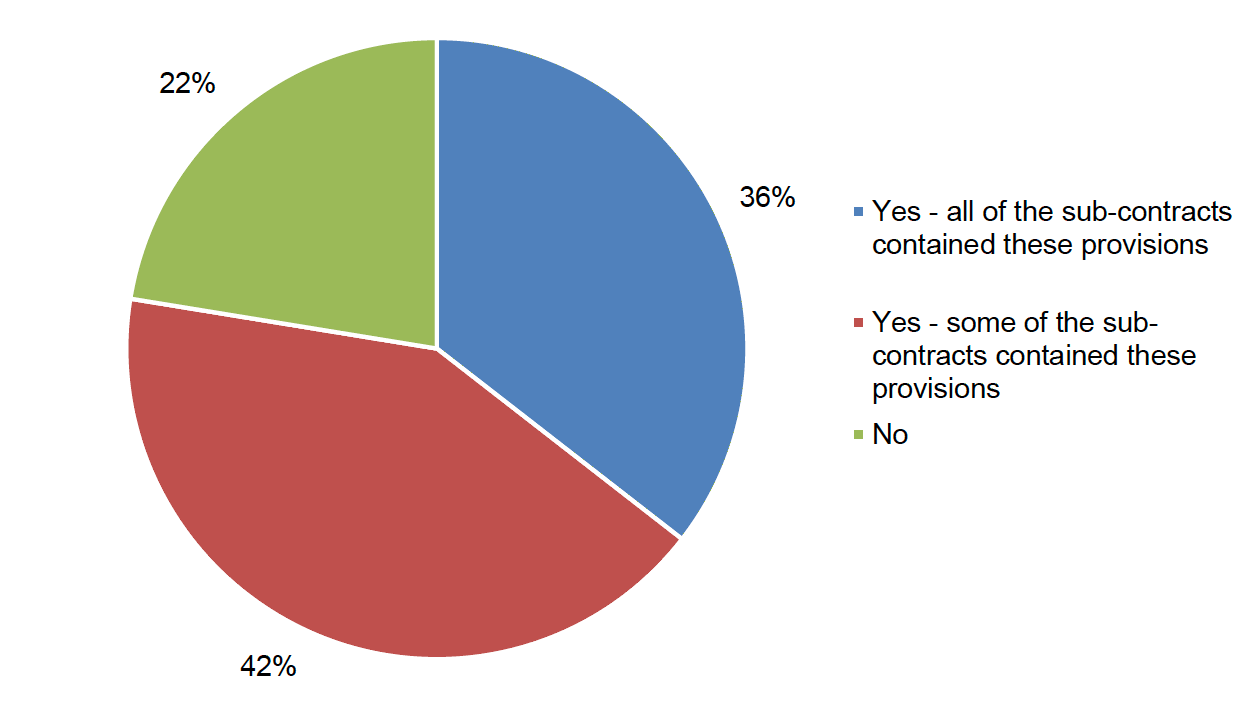
As shown above, over three quarters (78%) of respondents said that some or all of the sub-contracts where they were not paid within 30 days contained provisions that they would be paid within this timeframe.
Provisions around prompt payment are less likely to be contained within construction sub-contracts. When we consider construction firms only, 68% of respondents from this sector said that some or all of the sub-contracts where they were not paid within 30 days contained the relevant provisions.
When we exclude responses from those in the construction sector, the proportion of respondents indicating that some or all of the sub-contracts where they experienced late payment contained provisions that they would be paid within 30 days increases from 78% to 82%.
Other findings with regard to late payment included:
- 73% of all respondents indicated that they had experienced late payment as a sub-contractor with more than one public contract (compared with 82% of respondents from the construction sector only)
- 62% of all respondents said they had experienced late payment issues as a sub-contractor on at least two contracts with the same prime contractor (compared with 75% of respondents from the construction sector)
To understand more about these problems, we asked about the nature of any contracts where respondents experienced late payment. Of 212 respondents, almost three quarters (71%) had experienced late payment in connection with services contracts. The corresponding figures for works and goods contracts were 34% and 14% respectively.[22]
Naturally, suppliers are proactive in seeking to resolve late payment issues and most of our respondents felt it necessary to raise these issues. Of 213 respondents, 81% raised the issue directly with the contractor or sub-contractor delaying payment.[23]
However, some (16%) did not raise the issue with anyone. When explaining why they did not raise late payment issues, many respondents displayed a degree of indifference. There was a strong sense that respondents were confident that they would eventually be paid, that it was common in their industry not to be paid on time, or that there was simply no point in raising the issue.[24] As one respondent said:
"It is not normal for construction-based contractors to pay in 30 days to the extent that we believe this has never happened. The norm is we invoice, the first invoice is ignored, the second invoice brings some technicality that results in non-payment…. This can go on and on depending [on] the contractor involved."
For others, decisions not to raise late payment issues sometimes merely reflected the nature of the contract in question – for example, where payment terms were longer than 30 days.
Impact of work to improve Scottish public sector procurement
From a supplier perspective, although the overall picture is mixed, there are some positive indications that the public procurement landscape has improved in recent years. In relation to a variety of aspects of procurement, we asked respondents to rate the extent to which they agreed that the delivery of public procurement had changed for the better since 2016, when the 2014 Act began to take effect (Figure 3.14).Figure 3.14: Since 2016, to what extent do you believe that Scottish public procurement delivery…
Across all the questions, the majority of respondents either had a neutral or 'don't know' response, indicating that many suppliers do not have a strong or clear opinion in relation to progress in Scottish procurement. At least one third of respondents stated that they 'neither agreed nor disagreed' across all five categories, ranging from 36% (in respect of whether Scottish public procurement delivery has become simpler) to 41% (whether it has become more social enterprise/third sector friendly).
In relation to those respondents who specifically provided a 'don't know' response to any question, in particular, 26% did not know whether Scottish public procurement delivery has become more social enterprise/third sector friendly. This is despite the fact that facilitating the involvement of third sector organisations in the procurement process is a key component of the Sustainable Procurement Duty. The findings suggest that supplier awareness issues may be at play, with some suppliers potentially not having visibility of recent changes in the delivery of public procurement in certain areas.
That many respondents did not know or were unable to comment is likely to also be a reflection of the demographics of the supplier base represented in the survey. For example, just 6% of all respondents to the survey represented charities, voluntary sector organisations or social enterprises. Also, suppliers with stronger track records of tendering for public contracts were generally more likely to be able to provide a definitive opinion. For example, in relation to whether Scottish public procurement delivery has improved since 2016, 51% of respondents whose organisations have never tendered for a contract provided a 'don't know/not applicable' response, compared to 9% of respondents with over 20 years of tendering experience.
There are also some positives. Across three of the five response categories, respondents were more likely to respond positively (as indicated by an 'agree' or 'strongly agree' response) than they were to respond negatively (as indicated by a 'disagree' or 'strongly disagree'). Twenty eight per cent of respondents 'agreed' or 'strongly agreed' that Scottish public procurement delivery has become more open and transparent since 2016, while 26% 'agreed' or 'strongly agreed' that it has improved on the whole. Moreover, around a fifth (19%) of respondents 'agreed' or 'strongly agreed' that Scottish public procurement delivery has become more social enterprise/third sector-friendly.
Among those who commented further on the extent of positive change in public procurement since 2016, there were again some positives. For example, we heard that:
"A stronger emphasis on quality rather than a blanket approach to price has led to contracts becoming more sustainable for all parties involved and more open to greater Public and Private sector bodies working jointly to deliver better outcomes."
However, it was again common for suppliers to stress that public procurement remains, in their view, too complex. We heard that the process of submitting a tender can often be difficult, lengthy and/or otherwise burdensome, with some respondents also highlighting the often stringent demands of the bidding process or of the contract itself – for example, the legal information required or the community benefit requirements imposed. For example, one respondent recognised the positive impact that the Public Contracts Scotland (PCS) portal has had on the tendering process, but also highlighted the arduous nature of other tendering portals that are still in use:
"I think that since [PCS] was launched, tendering has improved considerably. When I started with the business in 2007, tenders were all done via hard copy and letters. And then it was [the] Public Tenders Scotland[25] portal which was only accessible by PC [and] we use Macs. So I had to go to the local library to do bids. To be honest, I cannot stand [the] PTS portal as it is so old fashioned and difficult compared to PCS. Sometimes if a tender is advertised and it is via this portal, we think twice about bidding because it is so onerous and inefficient."
Many respondents also expressed the view that public procurement is not a level playing field, with the same suppliers often winning multiple contracts. In particular, there was a sense that SMEs, third sector organisations and local suppliers often lose out to larger, multi-national companies. For example, we heard from one supplier that larger organisations are better-suited to delivering community benefits and because of this, smaller organisations can sometimes struggle to compete in the tendering process.
For a few respondents, issues remain around accessing public contracts and identifying relevant opportunities. For example, one participant stressed the usefulness of the Irish tendering system compared to the Scottish system, and the difficulties that SMEs face when it comes to searching for Scottish tenders:
"The Irish tender system proactively sends tender opportunities to prospective tenderers in response to their selected key words. This can happen on a daily basis and makes it far easier for prospective tenderers to identify and respond to opportunities. SMEs do not always have the time and resources to search the Scottish system."
To deepen our understanding of the extent to which recent efforts to improve Scottish public procurement have had a positive impact on practice, we asked respondents to identify what impact, if any, the work to improve Scottish public procurement has had on a range of aspects of procurement (Figure 3.15).
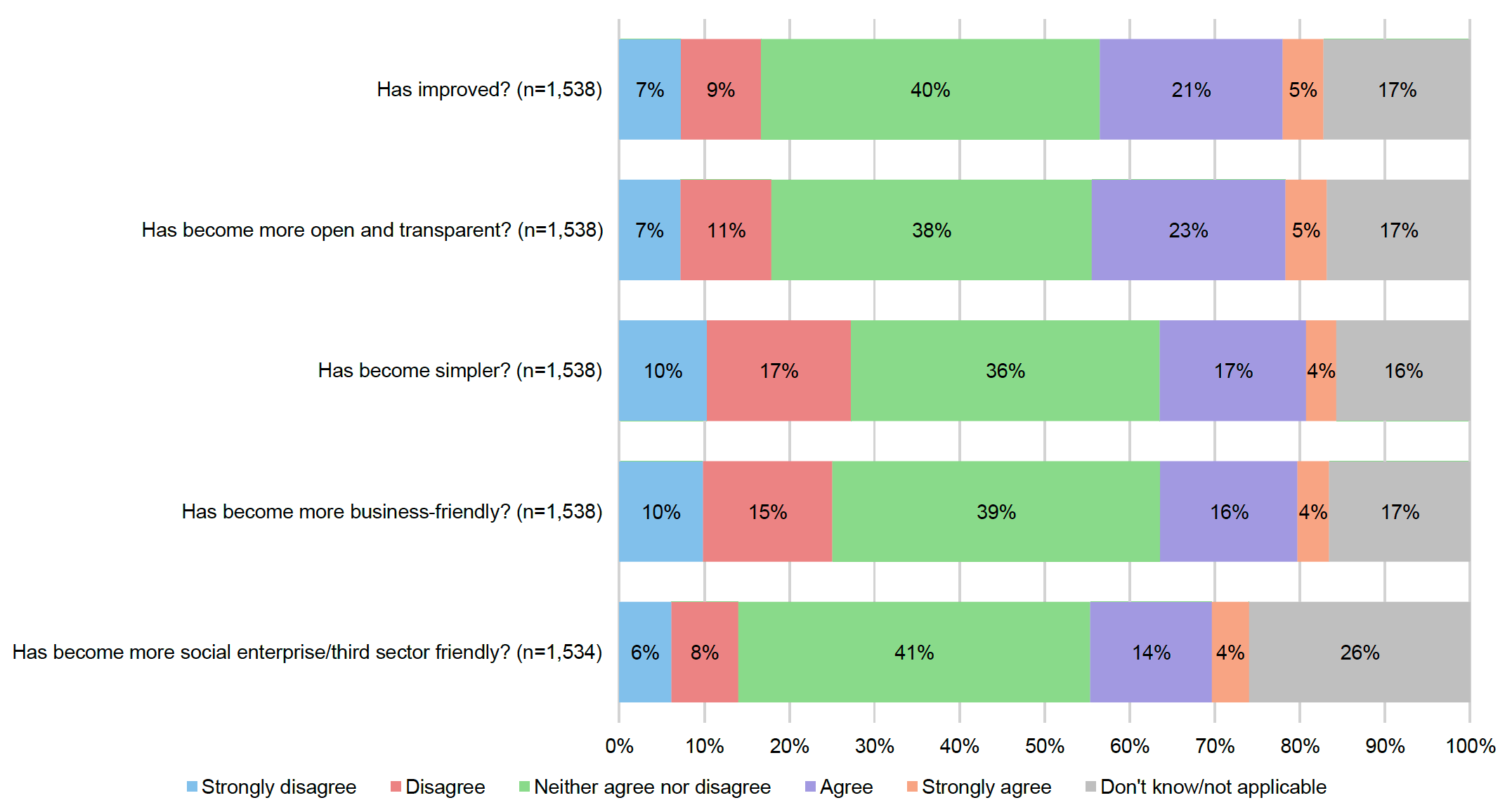
As we have seen elsewhere, across all questions, considerable numbers of suppliers provided an 'I don't know' response. These findings again suggest that supplier awareness of various aspects of public procurement may be relatively low, including those relating to the Sustainable Procurement Duty. For example, 38% of respondents did not know whether the work to improve Scottish public procurement has had any impact in relation to the participation of SMEs, third sector organisations and supported businesses, while 30% did not know about the potential impact in relation to encouraging innovation. This is despite the fact that these two aspects of procurement are important components of the Duty.
It may again also be a reflection of respondent demographics. For example, that 46% of respondents did not know whether there had been any changes in encouraging consortia bidding may reflect the fact that only 13% of survey respondents indicated that their organisation had experience of being part of a consortium bid.
Also, as we have seen elsewhere, suppliers with more experience of tendering for contracts were more likely to be able to comment on the impact of work to improve public procurement. For example, in relation to whether such work has led to greater transparency and clarity in the procurement process, 64% of respondents from firms which have never tendered provided an 'I don't know' response, compared to 13% of respondents from firms with over 20 years of tendering experience.
As Figure 3.15 shows, for each response category, respondents were considerably more likely to return positive results than negative. In particular, 40% of respondents felt that there had been either some or a lot of improvement in the embedding of social and environmental matters in the procurement process in recent years. Other areas where respondents were especially positive included:
- transparency and clarity in the procurement process, e.g. making it easier to locate, understand and bid for contracts (34% reported that this had either somewhat improved or improved a lot);
- public sector engagement with suppliers (27%);
- encouraging innovation (27%).
Again, the findings suggest that issues around access to public contracts centre largely on SME access. Large businesses were more likely than SMEs to report positive changes in relation to transparency and clarity in the procurement process; while 32% of SMEs felt that this had either somewhat improved or improved a lot, the corresponding figure for large businesses was 49%.
Findings earlier in this report suggested that there is an opportunity for improvement in relation to encouraging innovation in public procurement (Figure 3.9). Coupled with the findings outlined in Figure 3.15, it is clear that some progress has indeed been made in encouraging innovation in recent years, and that the emphasis now should be on ensuring that we build on this and that we continue to strive for further improvement.
Clearly, however, there are some areas for improvement. Across all response categories, significant proportions of suppliers indicated that there had been no change in recent years. The proportions of suppliers indicating as such ranged from 26% (in relation to embedding social and environmental matters in the procurement process) to 37% (in relation to the quality and consistency of feedback). This does not necessarily indicate that there has been no such change in recent years – rather, it may suggest that such change is not visible to suppliers, or that change has been more gradual in nature.
Fourteen per cent of respondents felt that the visibility of low value contracts had got either somewhat or a lot worse. Broken down further, 16% of SMEs indicated that visibility of low value contracts had got somewhat or a lot worse, compared with 5% of large businesses – again, this indicates that SMEs are more vulnerable to experiencing challenges accessing public contracts than large businesses.
Some sectors appear particularly vulnerable where the visibility of low-value contracts is concerned. For example, out of 126 respondents in the information and communication sector, 17% felt that the visibility of low value contracts had got either somewhat or a lot worse (compared with 14% of all firms).
The COVID-19 pandemic
The COVID-19 pandemic has had a significant impact on businesses supplying to the public sector in Scotland, and although suppliers have access to a range of streams of support, a significant proportion of respondents had not benefited from any of these. We asked respondents to indicate to what extent, if any, the pandemic has had a negative impact on their organisations' ability to bid for and/or deliver a Scottish public sector contract (Figure 3.16).
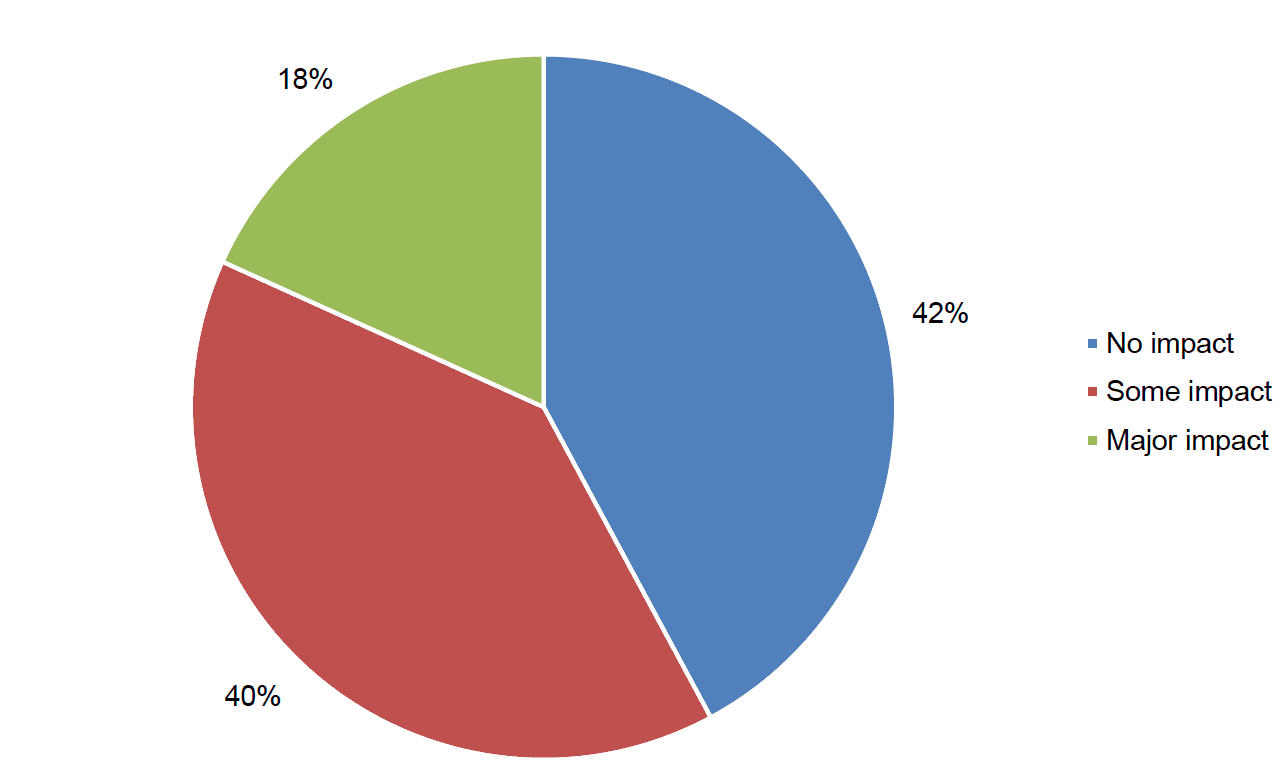
Clearly, COVID-19 has had either some or a major negative impact on most suppliers, with 58% of respondents indicating as such. For 18% of suppliers, the pandemic has had a major negative impact on their organisation.
During the pandemic, suppliers have experienced a range of barriers to bidding and/or delivering a Scottish public sector contract. These barriers are summarised overleaf.
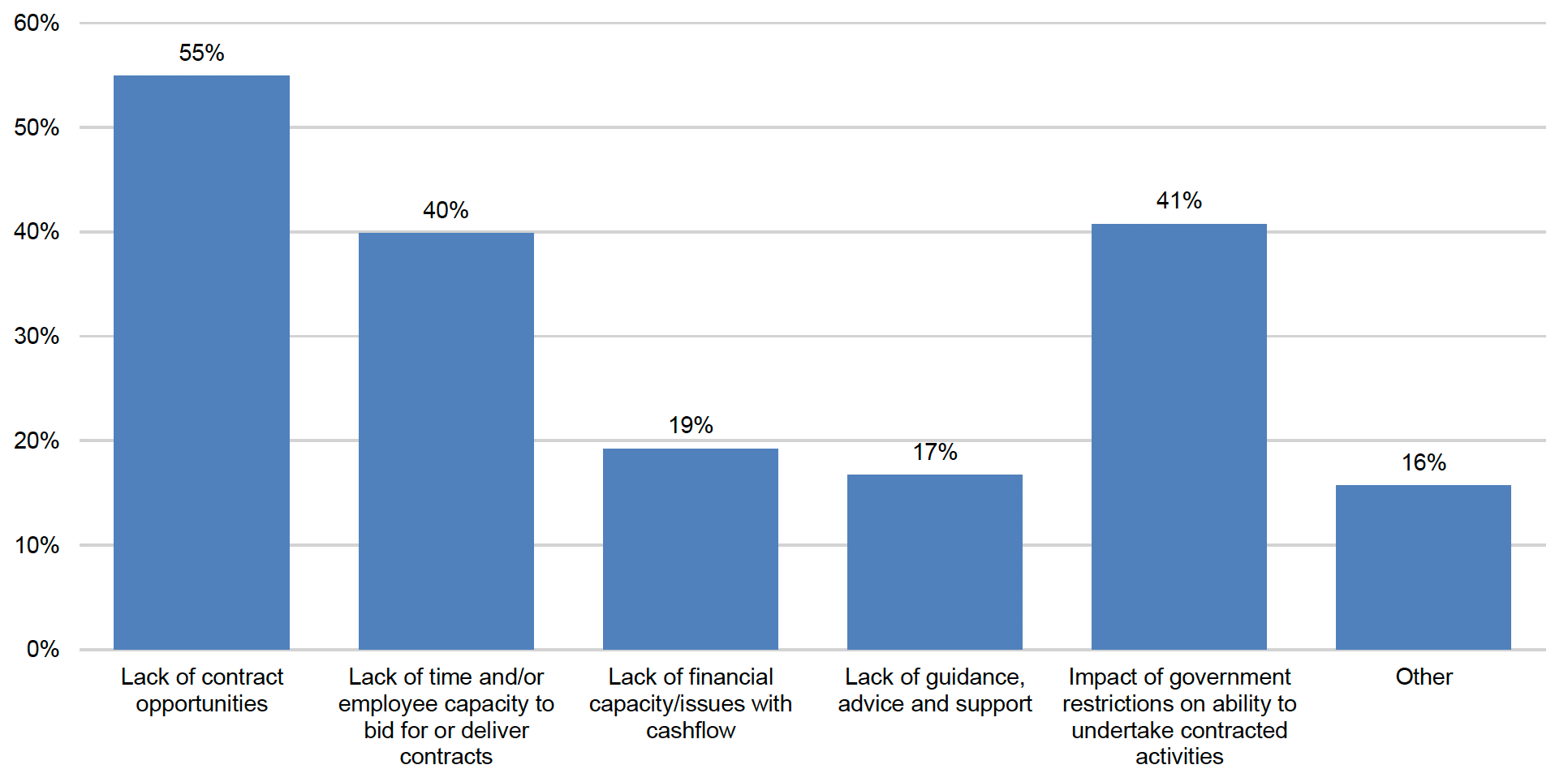
For most, the difficulties in bidding for and/or delivering contracts resulted from a lack of contract opportunities in the first place, with 55% indicating as such. Again, this was especially challenging for SMEs. Fifty-seven per cent of SMEs highlighted a lack of contract opportunities during the pandemic, compared with 43% of large businesses.
Other difficulties highlighted by respondents of all business sizes included government restrictions, which have had a negative impact on suppliers' ability to undertake contracted activities (indicated by 41% of respondents). Forty per-cent of respondents felt hindered by a lack of time and/or employee capacity to bid for or deliver contracts.
A relatively small proportion of suppliers (16%) highlighted other important barriers affecting their ability to bid for or deliver contracts during the pandemic. Several participants reflected on the difficulties engaging and building relationships with public bodies during the bidding process – for example, we heard that the "final stage face-to-face [interview] over video conferencing hampers [our] ability to engage". Others highlighted the issues posed by the delay of tenders, the closure of buildings and sites, customer delays and issues with receipt of supplies.
Not all suppliers have received support during the pandemic. We asked respondents whether they or their organisation received any support from local government, national government or elsewhere to help reduce the impact of COVID-19 on their business. Of 1,537 respondents, 44% indicated 'no'.
Among those suppliers who have received support during the pandemic, such support has taken a variety of forms and has come from a range of organisations across the public sector. We asked respondents to provide information about the support they received during the pandemic (Table 3.1).
| Support received | Proportion of respondents |
|---|---|
| Modifications to existing public sector contracts (e.g. advanced payments) | 6% |
| Furloughed staff | 76% |
| Small Business Support Grant | 32% |
| Pivotal Enterprise Resilience Fund | 3% |
| Self-Employment Income Support Scheme | 10% |
| Self-Employed Hardship Fund | 1% |
| Bounce Back Loan Scheme | 19% |
| Coronavirus Business Interruption Loan Scheme (CBILS) | 7% |
| Other financial/grant support from a public sector body (e.g. Third Sector Resilience Fund, Wellbeing Fund, Supported Communities Fund) | 7% |
| Other | 6% |
Generally, the support received was of a financial nature. As shown above, the furlough scheme was the most common form of support taken up by suppliers during the COVID-19 pandemic, with 76% of respondents reporting that they have furloughed staff. Around one third (32%) of respondents were recipients of a Small Business Support Grant, while 19% reported taking part in the Bounce Back Loan Scheme.
A small proportion (6%) of respondents indicated that they had received other types of support. Again, much of this support was financial, with participants referring to, for example, tax and VAT deferral, rates relief and other grants and funding streams. Several also highlighted practical support they had received, such as the receipt of PPE, advice and guidance, and operational support.
In relation to public procurement matters specifically, the survey responses suggest that additional support would have been helpful. We asked respondents what other support, if any, would have helped their organisation to bid for or deliver contracts during the pandemic. Although many felt that they did not require any other support, or could not identify what else may be needed, several respondents highlighted a clear need for more guidance, support and training – either in relation to procurement and contract delivery during the pandemic, or to the procurement process more widely. For example, one participant felt there was a need for clearer guidance on what constituted 'essential work' during the pandemic:
"[We would have liked] clearer guidance [regarding] 'essential work'. If the contract had been placed during the pandemic, to be delivered in the pandemic, surely this equates to essential work, or the contract should not have been advertised? We have had confusion and difficulties [regarding] carrying out work during the pandemic as the public sector body has told us we are not able to travel to hold essential site visits/surveys etc, despite these being outside and/or manageable within the COVID-19 restrictions."
Some respondents stressed the need for more tender opportunities or for bidding to be made easier – in particular, by extending the timescales for bidding. We also heard from a few respondents that smaller businesses and local firms required more support, for example financial support.
From a supplier perspective, a variety of lessons – both positive and negative – can be learned from the COVID-19 pandemic in relation to Scottish public sector procurement. Some suppliers highlighted the increased flexibility that the pandemic has brought to the procurement process and to organisations' ways of working, owing to homeworking arrangements and the increased use of technology. Others felt that they had been well-supported during the pandemic, with good lines of communication between public sector bodies and their suppliers across the supply chain. Comments from respondents included:
"The use of Zoom and Team conferencing software has made bidding for Scottish contracts possible. Previously the cost of flying to Scotland for meetings and project management as well as open days precluded us from bidding."
"Home working actually helps bidding! As the office manager and main bid organiser, I now have time and peace to write and collate bids."
For other respondents, the pandemic has merely brought existing challenges with Scottish public sector procurement into the spotlight. Among many, there was a sense that more could have been done during the pandemic – and that more still can be done – to help SMEs, sole traders and local businesses in particular. Others highlighted the need for a more streamlined and simpler tendering process, or emphasised the need for greater flexibility in the procurement process:
"The process needs to be simplified in relation to SMEs bidding for work, especially in the strictures expected where SMEs are collaborating."
"Change the opportunities available to make more desk based work available that could be done from home."
We also heard from respondents who felt that the supplier base would have benefited from more communication from the public sector. This applied to both communication during the tender process and during contract delivery. For example, as one participant said:
"Communication of the status of future tenders and PQs[26] – which is vital for business to plan for resources and future workload, especially when staff have been furloughed – could have been better."
Final reflections from respondents
Respondents were invited to provide any final comments on their experiences of bidding for Scottish public sector contracts. Several suppliers ended by providing positive reflections on the procurement process, some of whom praised particular aspects of the tendering process such as the Quick Quote system and the use of online tendering portals.
"Overall the platform seems fairly straightforward and once access was achieved, we have been able to use [it] without too much issue. The support for access requirements from the tender manager has been very good."
"We work across the UK and the Scottish system is by far the best in the UK – much clearer and simpler, easier to use, more comprehensive. The Quick Quote system has been invaluable."
Again, however, many highlighted that there is room for improvement with regard to Scottish public sector procurement, and especially so in relation to procurements involving SMEs and sole traders. Many respondents again stressed the complexities of the system and the difficulties that they sometimes face navigating it, understanding tenders and responding to stringent criteria in an often highly-competitive environment. Some felt that more guidance and support is thus required in relation to the bidding process. Comments from respondents included:
"I strongly suggest the use of appropriate page limits for tenders. Often these are not in place. Also, it often seems that bidders are asked to provide just as much information for lower value tenders as for higher value tenders – could this be streamlined? There are often quite extensive 'not scored' sections which require lots of information to be provided; procurement should consider whether this is necessary if these sections are not being scored in any case."
"For us, as a small consultancy, the insurance requirements are huge and do not make sense. No client has been able to identify a situation where we would need [these]."
On a related note, many respondents referred to the time-consuming nature of the procurement process and the 'costs' involved in submitting a bid:
"[Procurement] can be a full time post on top of everyday work for SMEs who struggle to finance a worker dedicated to procurement."
"Just because there needs to be a minimum of 35 days for submission, that does not mean that it has to be 35 days. Make it 40 or 50; complex specifications, drive for innovation and partnerships take time. Allow that time. [Local authorities] take months and months (years!) to come up with a specification, then expect organisations to fully decipher it, look at alternative, innovative solutions, look for partners and write a comprehensive submission in 35 days, and usually at a very inappropriate time for an individual organisation."
Some respondents felt that they are missing out on procurement opportunities, or on information about contracts awarded. As one respondent said:
"Visibility of contracts is difficult, and large quantities of them are much more accosted with working with larger consortia to get on them. Working in the building industry, local government tends to procure all services though one. We are not contacted or informed, so it is tough to know what projects are being bid for and who has applied to bid on them. Finding out is very time-consuming."
Contact
Email: socialresearch@gov.scot
There is a problem
Thanks for your feedback